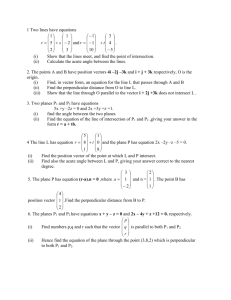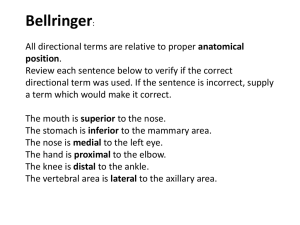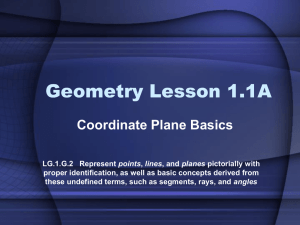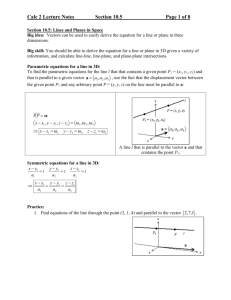Calculus III: Planes, Cylinders & Quadric Surfaces Lecture Notes
advertisement
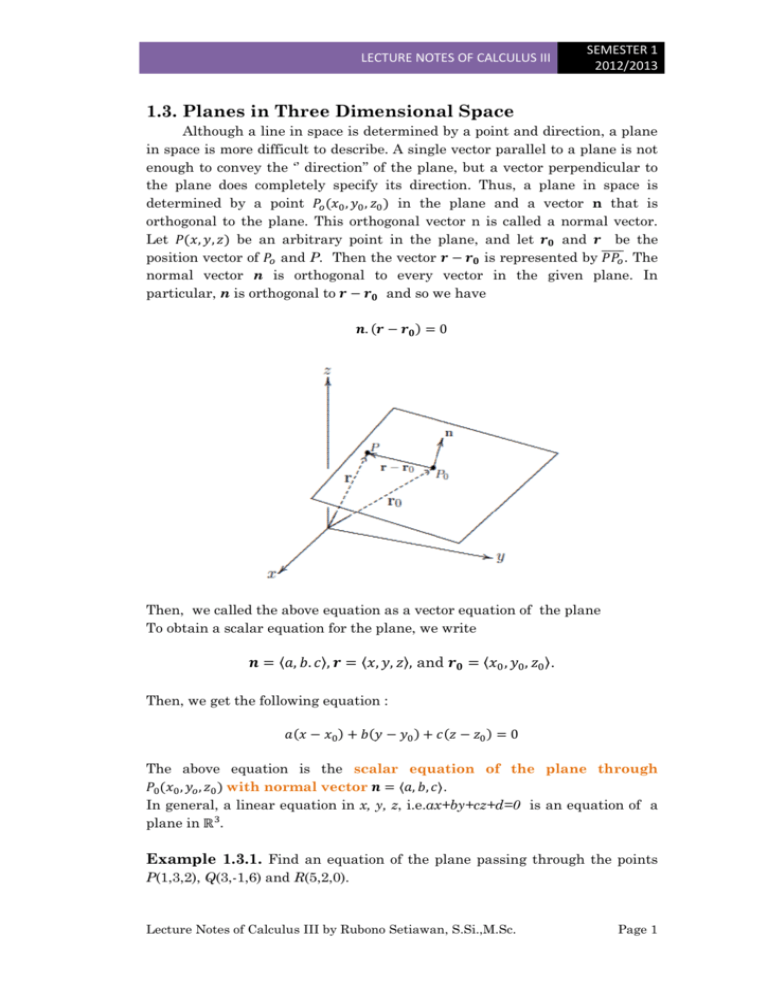
LECTURE NOTES OF CALCULUS III SEMESTER 1 2012/2013 1.3. Planes in Three Dimensional Space Although a line in space is determined by a point and direction, a plane in space is more difficult to describe. A single vector parallel to a plane is not enough to convey the ‘’ direction’’ of the plane, but a vector perpendicular to the plane does completely specify its direction. Thus, a plane in space is determined by a point 𝑃𝑜 (𝑥0 , 𝑦0 , 𝑧0 ) in the plane and a vector n that is orthogonal to the plane. This orthogonal vector n is called a normal vector. Let 𝑃(𝑥, 𝑦, 𝑧) be an arbitrary point in the plane, and let 𝒓𝟎 and 𝒓 be the position vector of 𝑃𝑜 and P. Then the vector 𝒓 − 𝒓𝟎 is represented by ̅̅̅̅̅ 𝑃𝑃𝑜 . The normal vector n is orthogonal to every vector in the given plane. In particular, n is orthogonal to 𝒓 − 𝒓𝟎 and so we have 𝒏. (𝒓 − 𝒓𝟎 ) = 0 Then, we called the above equation as a vector equation of the plane To obtain a scalar equation for the plane, we write 𝒏 = ⟨𝑎, 𝑏. 𝑐⟩, 𝒓 = ⟨𝑥, 𝑦, 𝑧⟩, and 𝒓𝟎 = ⟨𝑥0 , 𝑦0 , 𝑧0 ⟩. Then, we get the following equation : 𝑎(𝑥 − 𝑥0 ) + 𝑏(𝑦 − 𝑦0 ) + 𝑐(𝑧 − 𝑧0 ) = 0 The above equation is the scalar equation of the plane through 𝑃0 (𝑥0 , 𝑦𝑜 , 𝑧0 ) with normal vector 𝒏 = ⟨𝑎, 𝑏, 𝑐⟩. In general, a linear equation in x, y, z, i.e.ax+by+cz+d=0 is an equation of a plane in ℝ3 . Example 1.3.1. Find an equation of the plane passing through the points P(1,3,2), Q(3,-1,6) and R(5,2,0). Lecture Notes of Calculus III by Rubono Setiawan, S.Si.,M.Sc. Page 1 LECTURE NOTES OF CALCULUS III SEMESTER 1 2012/2013 ̅̅̅̅ and 𝑃𝑅 ̅̅̅̅ are : Solution. The vector a and b corresponding to 𝑃𝑄 𝒂 = ⟨2, −4,4⟩ 𝒃 = ⟨4, −1, −2⟩ Since both a and b lie in the plane, their cross product 𝒂 × 𝒃 is orthogonal ( i.e. the direction of 𝒂 × 𝒃 is perpendicular to the respective plane ) to the plane and can be taken as the normal vector. Thus 𝒊 𝒋 𝒌 𝒏 = 𝒂 × 𝒃 = |2 −4 4 | = 12𝒊 + 20𝒋 + 14𝒌 = ⟨12,20,14⟩. 4 −1 −2 Therefore, with the point P(1,3,2) and the normal vector n, an equation of the plane is given by : ⟨12, 20,14⟩. ⟨𝑥 − 1, 𝑦 − 3, 𝑧 − 2⟩ = 0 12(𝑥 − 1) + 20(𝑦 − 3) + 14(𝑧 − 2) = 0 or 6𝑥 + 10𝑦 + 7𝑧 = 50. Example 1.3.2. Find the point at which the line with parametric equations 𝑥 = 3 − 𝑡, 𝑦 = 2 + 𝑡, 𝑧 = 5𝑡, where t is the parametric value, intersect the plane 𝑥 − 𝑦 + 2𝑧 = 9. Solution. We subtitute the expressions for x, y and z from parametric equations into the equations of the plane : (3 − 𝑡) − (2 + 𝑡) + 2(5𝑡) = 9. So, we get 𝑡 = 1. Therefore, the point of intersection occurs when parameter value is 𝑡 = 1. Then 𝑥 = 2, 𝑦 = 3 and 𝑧 = 5, hence the point of intersection is (2,3,5). Definition 1.3.3. Two planes are parallel if their normal vector are parallel. For instance, let’s see the following example : Example 1.3.4. The planes 𝑥 + 2𝑦 − 3𝑧 = 4 and 2𝑥 + 4𝑦 − 6𝑧 = 3 are parallel because their normal vectors are 𝒏𝟏 = ⟨1,2, −3⟩ and 𝒏𝟐 = ⟨2,4, −6⟩ and 𝒏𝟐 = 2𝒏𝟏 . If two planes are not parallel, then they intersect in a straight line and the angle between the two planes is defined as the acute angle between their normal vectors. See the following figure : Lecture Notes of Calculus III by Rubono Setiawan, S.Si.,M.Sc. Page 2 LECTURE NOTES OF CALCULUS III SEMESTER 1 2012/2013 Figure 1.3.1 Example 1.3.5. a. Find the angle between the planes 𝑥 + 𝑦 + 𝑧 = 1 and 𝑥 − 2𝑦 + 3𝑧 = 1. b. Find the symmetric equations for the line of intersection L of these two planes. Solution. a. The normal vectors of these planes are 𝒏𝟏 = ⟨1,1,1⟩ 𝒏𝟐 ⟨1, −2,3⟩ and so, if 𝜃 is the angle between the planes, then cos 𝜃 = 𝒏𝟏 . 𝒏𝟐 1(1) + 1(−2) + 1(3) 2 = = |𝒏𝟏 ||𝒏𝟐 | √1 + 1 + 1√1 + 4 + 9 √42 2 𝜃 = 𝑐𝑜𝑠 −1 ( ) = 720 √42 b. We first need to find a point on L. For instance, we can find the point where the line intersect the xy-plane by setting 𝑧 = 0 in the equations of both planes. This gives the equations 𝑥 + 𝑦 = 1 and 𝑥 − 2𝑦 = 1, whose solution is 𝑥 = 1, 𝑦 = 0. So the point (1, 0, 0 ) lies on L. Now, we observe that, since L lies in both planes, it is perpendicular to both of the normal vectors. Thus, a vector 𝒗 parallel to L is given by the cross product 𝒊 𝒋 𝒌 𝒗 = 𝒏𝟏 × 𝒏𝟐 = |1 1 1| = 5𝒊 − 2𝒋 − 3𝒌 1 −2 3 So, the symmetric equation of line L can be written as : 𝑥−1 𝑦 𝑧 = = 5 −2 −3 The following figure shows the plane in Example 1.3.5 and their line of intersection L Lecture Notes of Calculus III by Rubono Setiawan, S.Si.,M.Sc. Page 3 LECTURE NOTES OF CALCULUS III SEMESTER 1 2012/2013 Figure 1.3.2. In general, when we write the equations of a line in the symmetric form 𝑥 − 𝑥0 𝑦 − 𝑦0 𝑧 − 𝑧0 = = 𝑎 𝑏 𝑐 We can regard the line as the line of intersection of two planes 𝑥 − 𝑥0 𝑦 − 𝑦0 = 𝑎 𝑏 and 𝑦 − 𝑦0 𝑧 − 𝑧0 = 𝑏 𝑐 Proposition 1.3.6. The distance from 𝑃1 (𝑥1 , 𝑦1 , 𝑧1 ) to the plane 𝑎𝑥 + 𝑏𝑦 + 𝑐𝑧 + 𝑑 = 0 is |𝑎𝑥1 + 𝑏𝑦1 + 𝑐𝑧1 + 𝑑| √𝑎2 + 𝑏 2 + 𝑐 2 Example 1.3.7. Find the distance between the parallel planes 10𝑥 + 2𝑦 − 2𝑧 = 5 and 5𝑥 + 𝑦 − 𝑧 = 1. Solution. Then planes are parallel because the vector ⟨10,2, −2⟩ and ⟨5,1, −1⟩ are parallel. Pick any point on the plane 10𝑥 + 2𝑦 − 2𝑧 = 5. For example (1/2,0,0). Then the distance between the two planes is : |5(1⁄2) + 0(1) + 0(−1) − 1| √52 + 12 + (−1)2 = √3 6 Example 1.3.8. Find the distance between the skew lines 𝐿1 : 𝑥 = 1 + 𝑡, 𝑦 = −2 + 3𝑡, 𝑧 = 4 − 𝑡 𝐿2 : 𝑥 = 2𝑠, 𝑦 = 3 + 𝑠, 𝑧 = −3 + 4𝑠 Solution. As 𝑳𝟏 and 𝑳𝟐 are skew, they are contained in two parallel planes 𝑷𝟏 and 𝑷𝟐 respectively. The common normal vector to both planes Lecture Notes of Calculus III by Rubono Setiawan, S.Si.,M.Sc. Page 4 LECTURE NOTES OF CALCULUS III SEMESTER 1 2012/2013 must be orthogonal to both 𝒗𝟏 = ⟨1,3, −1⟩ ( the direction of 𝐿1 ) and 𝒗𝟐 = ⟨2,1,4⟩ ( The direction of 𝐿2 ). A normal to these two parallel planes is given by 𝒊 𝒋 𝒌 𝒏 = 𝒗𝟏 × 𝒗𝟐 = |1 3 −1| = ⟨13, −6, −5⟩ 2 1 4 Let, 𝑠 = 0 in 𝐿2 . We get the point (0,3,-3) on 𝐿2 . Therefore, an equation of the plane containing 𝐿2 is ⟨𝑥 − 0, 𝑦 − 3, 𝑧 + 3⟩. ⟨13, −6, −5⟩ = 0. That is 13𝑥 − 6𝑦 − 5𝑧 + 3 = 0. Let 𝑡 = 0 in 𝐿2 , then we get the point (1,-2, 4) in 𝐿1 . Hence, the distance between 𝐿1 and 𝐿2 is given by |13(1) − 6(−2) − 5(4) + 3| √132 + (−6)2 + (−5)2 = 8 √230 . 1.4. Cylinders and Quadric Surfaces In this section, we have already look at two special types of surfaces – planes and spheres. Here we investigate two other types of surfaces – cylinders and quadric surfaces. In order to sketch the graph of a surfaces, it is useful to determine the curves of intersection of the surface with planes parallel to the coordinate planes. These curves are called traces ( or cross – section ) of the surface. Definition 1.4.1. A Cylinder is a surface that consist all line ( called rulling that are parallel to a given line and pass through a plane curve. Example 1.4.1. Parabolic Cylinder 𝑧 = 𝑥 2 Figure 1.4.1. A parabolic cylinder Example 1.4.2. Circular Cylinders Lecture Notes of Calculus III by Rubono Setiawan, S.Si.,M.Sc. Page 5 SEMESTER 1 2012/2013 LECTURE NOTES OF CALCULUS III Figure 1.4.2. Circular Cylinder 𝑥 2 + 𝑦 2 = 1 and 𝑦 2 + 𝑧 2 = 1 When you dealing with surfaces, it is important to recognize that an equation like 𝑥 2 + 𝑦 2 = 1 represent a cylinder not a circle. The trace of the cylinder 𝑥 2 + 𝑦 2 = 1 in the xy-plane is the circle with equations 𝑥 2 + 𝑦 2 = 1, 𝑧 = 0. Definition 1.4.2. Quadric surface is the graph of the second degree equation in 𝑥, 𝑦, 𝑧 : 𝐴𝑥 2 + 𝐵𝑦 2 + 𝐶𝑧 2 + 𝐷𝑥𝑦 + 𝐸𝑦𝑧 + 𝐹𝑥𝑧 + +𝐺𝑥 + 𝐻𝑦 + 𝐼𝑧 + 𝐽 = 0. where A,B,C,D,E,F,G,H,I and J are real constant Using translation and rotation, the equation can be expressed is one of the following two standard form : 𝐴𝑥 2 + 𝐵𝑦 2 + 𝐶𝑧 2 + 𝐽 = 0 and 𝐴𝑥 2 + 𝐵𝑦 2 + 𝐼𝑧 = 0 Example 1.4.3. Use the trace to sketch the quadric surface with equation 𝑦2 𝑧2 𝑥 + + =1 9 4 2 Solution By subtituting 𝑧 = 0, we find that the trace in xy-plane is 𝑥 2 + 𝑦2 9 = 1. which we recognize as an equation of an ellipse. In general, the horizontal trace in the plane 𝑧 = 𝑘 is 𝑦2 𝑘2 𝑥2 + =1− 𝑧=𝑘 9 4 which is an ellipse , provided that 𝑘 2 < 4, −2 < 𝑘 < 2. Similiarly the vertical traces are also ellipses : Lecture Notes of Calculus III by Rubono Setiawan, S.Si.,M.Sc. Page 6 LECTURE NOTES OF CALCULUS III 𝑦2 9 + 𝑥2 + 𝑧2 4 𝑧2 4 = 1 − 𝑘2, 𝑥 = 𝑘 =1− 𝑘2 9 ,𝑦 = 𝑘 SEMESTER 1 2012/2013 ( if −1 < 𝑘 < 1) ( if −3 < 𝑘 < 3) Figure 1.4.3. The ellipsoid 𝑥 2 + 𝑦2 9 + 𝑧2 4 =1 Figure 1.4.3. is called an ellipsoid because all of its traces are ellipse. Notice that it is symmetric with respet to each coordinate plane; this is a reflection of the fact that its equation involves only even powers of x,y, and z. Example 1.4.4. The graph of the equation 𝑧 = 4𝑥 2 + 𝑦 2 is an elliptical paraboloid Figure 1.4.4. Elliptical paraboloid The horizontal traces in 𝑧 = 𝑘 are ellipses : 4𝑥 2 + 𝑦 2 = 𝑘, where 𝑘 > 0 The vertical traces in 𝑥 = 𝑘 are parabolas 𝑧 = 𝑦 2 + 4𝑘 2 . Similarly, the vertical traces in 𝑦 = 𝑘 are parabolas 𝑧 = 4𝑥 2 + 𝑘 2 Example 1.4.5. Skecth the surface Solution The trace in 𝑧 = 𝑘 are ellipses : 𝑥2 4 𝑥2 4 + 𝑦2 − + 𝑦2 = 1 + The trace in 𝑥 = 𝑘 are hiperbolas : 𝑦 2 − The trace in 𝑦 = 𝑘 are hiperbolas : 𝑥2 4 − 𝑧2 4 =1 𝑘2 4 𝑧2 𝑘2 = 1 − 4 4 𝑧2 = 1 − 𝑘2 4 Lecture Notes of Calculus III by Rubono Setiawan, S.Si.,M.Sc. Page 7 SEMESTER 1 2012/2013 LECTURE NOTES OF CALCULUS III Figure 1.4.5.a. The surface 𝑥2 4 + 𝑦2 − Figure 1.4.5.b. Vertical traces in 𝑦 = 𝑘 of 𝑥2 4 𝑧2 4 =1 + 𝑦2 − 𝑧2 4 =1 Example 1.4.6. Identity and skecth the surface 4𝑥 2 − 𝑦 2 + 2𝑧 2 + 4 = 0 Solution The equation can be rewritten in the standard form −𝑥 2 + 𝑦2 4 − 𝑧2 2 = 1. It is therefore a hyperboloid of 2 sheets along of the y – axis. The traces in the xyand yz-planes are the hyperbolas. −𝑥 2 + 𝑦2 4 = 1 𝑧 = 0 and 𝑦2 4 − 𝑧2 2 =1 𝑥=0 The surface has no trace in the xz-plane, but traces in the vertical planes 𝑦 = 𝑘 for |𝑘| > 2 are the ellipses. 𝑥2 + 𝑧2 𝑘2 = − 1, 𝑦 = 𝑘 2 4 which can be written as : Lecture Notes of Calculus III by Rubono Setiawan, S.Si.,M.Sc. Page 8 SEMESTER 1 2012/2013 LECTURE NOTES OF CALCULUS III 𝑥2 𝑧2 + = 1, 𝑘2 𝑘2 4 − 1 2 ( 4 − 1) 𝑦=𝑘 Figure 1.4.6. The planes 4𝑥 2 − 𝑦 2 + 2𝑧 2 + 4 = 0 Example 1.4.7 Classify the quadric surfaces 𝑥 2 + 2𝑧 2 − 6𝑥 − 𝑦 + 10 = 0. Solution By the method of completing squares, the equation can be written as 𝑦 − 1 = (𝑥 − 3)2 + 2𝑧 2 If we make change coordinates : 𝑥 ′ = 𝑥 − 3, 𝑦 ′ = 𝑦 − 1, 𝑧 ′ = 𝑧 so that the new 2 2 origin is at ( 3, 1, 0 ), then the equations becomes 𝑦 ′ = 𝑥 ′ + 2𝑧 ′ . Therefore it is an elliptic paraboid with vertex at (3,1,0). Figure 1.4.7. quadric surfaces 𝑥 2 + 2𝑧 2 − 6𝑥 − 𝑦 + 10 = 0. Lecture Notes of Calculus III by Rubono Setiawan, S.Si.,M.Sc. Page 9 LECTURE NOTES OF CALCULUS III SEMESTER 1 2012/2013 The graph of the quadric surfaces are summarized in the following table Lecture Notes of Calculus III by Rubono Setiawan, S.Si.,M.Sc. Page 10




